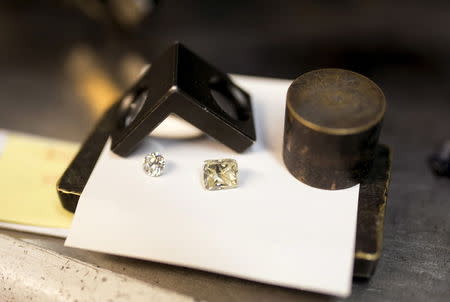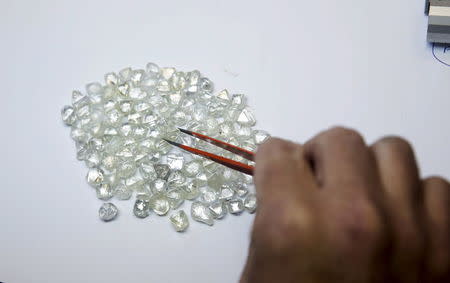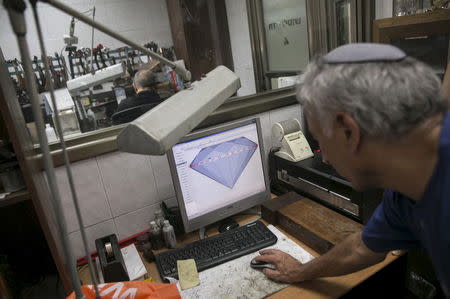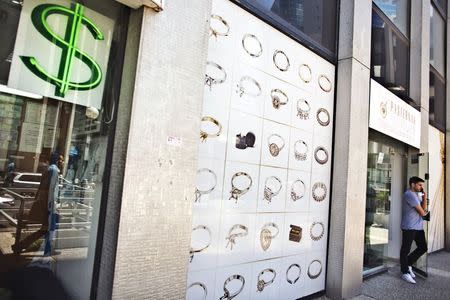Uncertain future for global diamond trade as profits vanish
By Tova Cohen and Ari Rabinovitch TEL AVIV (Reuters) - The family businesses that make up the global diamond trade have seen their profits wiped out over the past five years, hit by shaky financing, increased costs and uncertain demand from customers who prefer hi-tech gadgets to bling. Manufacturers who cut and polish diamonds have found themselves caught between giant mining companies charging high prices for rough stones, and big retail chains that demand gems at low margins to keep sales moving. While the $80 billion overall spent on diamond jewelry last year was a record, the manufacturers are expected to share a profit of just $100 million in 2015. That is half last year's total and down from $900 million in 2010, according to Chaim Even-Zohar of Tacy Ltd and Pranay Narvekar of Pharos Beam in Mumbai, two of the industry's top consultants. Even-Zohar estimated that 300,000 Chinese and Indian workers had been laid off out of nearly 1 million employed in gemcutting in those two countries, where most manufacturing takes place. "The rule of supply and demand doesn't necessarily apply to the diamond sector," said Yoram Dvash, a high-end polisher in Israel who outsources his rough stones to smaller Israeli polishers. Over the past year he has been sending his subcontractors 20 percent less volume. "Manufacturing is not just work, it's out of love - taking the rough stones, with all their odd shapes, and bringing out the most precious thing in the world. But this love costs a lot of money. And rough prices have been going up and up with no connection to demand." In the longer term, the industry needs to sustain consumer demand at a time when the prized possession of many people with disposable income is more likely to be a smartphone than a piece of jewelry. The hottest wristwatch this year does not have diamonds on its face - it has an Apple touch screen. "Have you ever heard of a 20-year-old standing outside a store all night to buy jewelry?" Ernest Blom, president of the World Federation of Diamond Bourses, asked delegates at an industry conference at a Tel Aviv luxury hotel. "I haven't," he answered. "We have fallen behind the times." Last month, the leading mining companies formed a Diamond Producers Association with a focus on stimulating consumer demand. But its annual budget is just $6 million, which many delegates at the conference said was not enough. HIGH COST MINERS The manufacturers and dealers depend on just a handful of miners, which control most of the world's diamond production and say they have had no choice but to pass on high costs further down the supply chain. No major deposits have been discovered in about two decades. The miners say they are investing heavily to keep supplies coming. Production in 2013 was down 26 percent since 2005, although estimates suggest it has risen slightly since. De Beers, a unit of South Africa's Anglo-American which is the market leading diamond miner in terms of value, says current projects are costing it more than $3 billion. Russia's Alrosa , the world's top producer by volume, just finished building three underground mines at $1 billion each. De Beers acknowledged that high costs for rough diamonds were forcing changes on gemcutters. "Overall, this trend is expected to affect the way the industry operates," De Beers said a 2014 report. Less well-established midstream companies may have to close, it said, forcing a consolidation in the market. Martin Rapaport, whose Rapaport Group is the primary source of diamond price information, said the miners had taken an unsustainable short-term approach by charging high prices. When polishers and traders can no longer afford to buy rough diamonds, De Beers and Alrosa will suffer. To prevent this, they will have to lower prices, and "no longer make windfall profits," he said. De Beers has already reduced its output forecast for 2015 because of weaker demand. Alrosa's prices have fallen 6 percent this year. Alrosa President Andrey Zharkov told Reuters the price drop "will help the manufacturers have enough oxygen in order to generate profits and keep consuming". Nevertheless, the company said it still sees prices rising later this year. RETAIL CONSOLIDATION Manufacturers' margins are also being squeezed by retailers, including big chains that have been consolidating to cut costs. Last year, the two largest U.S. mid-tier jewelry store chains combined, with Signet Jewelers buying Zale Corp for $1.46 billion. Hong Kong's Chow Tai Fook Jewellery Group <1929.HK>, the world's largest retailer by market value, bought U.S.-based Hearts on Fire for $150 million. Even-Zohar said that although overall retail jewelry sales were buoyant, jewelers were now putting fewer and smaller diamonds in their pieces. "There is little comfort for a diamond manufacturer or trader if the retail jeweler sells more diamond jewelry, when the pieces contain less diamonds. So much for the retail growth figures," he said. The low profits make it harder for manufacturers to pay for the financing they need to buy rough diamonds and hold them until they can be sold. Even-Zohar and Narvekar estimate this debt totaled $15.4 billion at the end of last year. The manufacturers service the debt while they work on the diamonds, bearing the risk that prices could fall before they have a finished product to sell. That risk has put off banks, which have cut back lending or pulled out entirely. Israel's Bank Leumi closed its diamond business and Belgian group KBC said it was winding down Antwerp Diamond Bank. Lenders in Dubai, like the National Bank of Fujairah , have tried to fill the financing gap, but traders say it is not enough. (Editing by Peter Graff)









